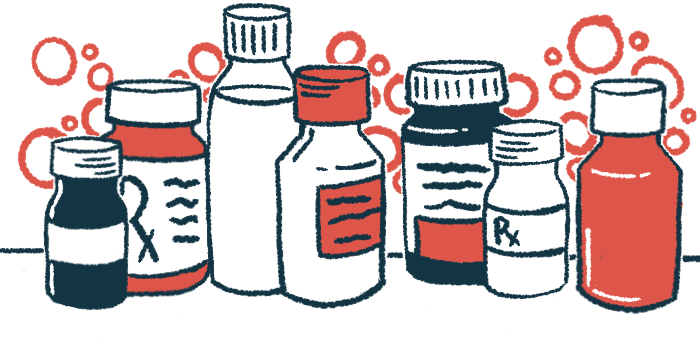#NACFC2022 – LAU-7b May Prevent Lung Function Decline in CF
APPLAUD trial seen to support therapy's 'inflammation-controlling potential'

Treatment with LAU-7b, an oral form of fenretinide being developed by Laurent Pharmaceuticals, may help prevent lung function decline in adults with cystic fibrosis (CF), particularly those with mild disease, according to results from a Phase 2 clinical trial.
Larry Lands, MD, PhD, the company’s chief medical advisor and a co-lead trial investigator, shared the findings at the 2022 North American Cystic Fibrosis Conference (NACFC) in the presentation, “Results from APPLAUD Phase 2 Study with Pro-Resolution Drug Candidate LAU-7b in Adults with Cystic Fibrosis.” The work was funded by Laurent and the Cystic Fibrosis Foundation.
LAU-7b is an orally available form of fenretinide, an artificial retinoid — a class of compounds related to vitamin A — that may help to ease the chronic inflammation that occurs in the lungs of people with CF.
LAU-7b use in APPLAUD seen to possibly complement CFTR modulator therapy
The Phase 2 APPLAUD (NCT03265288) study enrolled 166 adults with CF at 40 sites across the U.S., Canada, and Australia. Participants were randomly assigned to either LAU-7b or a placebo for six treatment cycles.
In each cycle, participants took LAU-7b or a placebo every day for three weeks, then went one week without their assigned capsule. They remained on their standard-care therapies during the study, which ran for about six months.
At the study’s start, all participants had a percentage predicted forced expiratory volume in one second (ppFEV1) between 40% and 100%. ppFEV1 is a standard measure of lung function based on how much air someone can forcibly exhale in a second.
In the overall study population, the change in ppFEV1 across 24 weeks — an analysis that considers change over the entire study’s months, rather than values only at its end — was nearly one point higher among patients given LAU-7b relative to those on a placebo. This difference, however, was not statistically significant.
But the ppFEV1 change in participants who completed at least five months of treatment was statistically significant, with a 1.23-point difference favoring LAU-7b over placebo. Results showed a 49% reduction in lung function decline with LAU-7b that was clinically meaningful.
In a subset analysis of patients with mild lung disease — specifically, individuals with a ppFEV1 of 70% or better at the study’s start — the difference in ppFEV1 decline through the end of treatment also favored LAU-7b over placebo, by 1.21 points.
Positive trends also were seen among patients taking CFTR modulators, including the triple-combination therapy Trikafta (elexacaftor, tezacaftor, and ivacaftor), though the differences between groups did not reach statistical significance.
“The potential clinical benefits of reducing the loss of lung function demonstrated with LAU-7b in the APPLAUD study, especially when administrated on top of CFTR modulators, are very promising and represent a first with a drug candidate addressing inflammation in adults with CF,” Michael Konstan, MD, co-lead investigator for the study, said in a press release.
At the study’s end, levels of C-reactive protein and of calprotectin were significantly lower for patients on LAU-7b compared to those on placebo, “confirming the inflammation-controlling potential” of LAU-7b, Lands said.
All study patients had at least one pulmonary exacerbation — a sudden worsening of lung function, generally associated with infection — in the year before entering the APPLAUD study. The number of exacerbations was similar in the LAU-7b and placebo groups during the trial.
LAU-7b shows ‘potential to rescue and preserve CFTR modulator’s effects during cellular stress’
The safety profile of LAU-7b was acceptable, according to Lands, with an incidence of treatment-emergent adverse events (those not present before treatment or worsening after treatment) slightly higher in the LAU-7b group. He noted that this difference was mainly due to self-reported ocular (eye) events, “a mild and transient known side effect of LAU-7b.” No life-threatening events or deaths were reported.
In his conclusion, Lands noted that the results support use of ppFEV1 “as the primary efficacy variable for confirmatory studies” which include a longer treatment period.
“These results showed that the proposed LAU-7b treatment approach is complementary to CFTR modulation, confirming earlier preclinical research by McGill [University] researchers demonstrating LAU-7b’s potential to rescue and preserve CFTR modulator’s effect during cellular stress,” Lands added.
Radu Pislariu, MD, Laurent’s president and CEO, thanked study patients and their families for their “trust in us,” and the clinical site researchers and the CF Foundation “for their support and partnership throughout this study, conducted in unprecedented pandemic conditions.”
Note: The Cystic Fibrosis News Today team is providing in-depth coverage of the 2022 North American Cystic Fibrosis Conference (NACFC) Nov. 3-5. Go here to see the latest stories from the conference.








